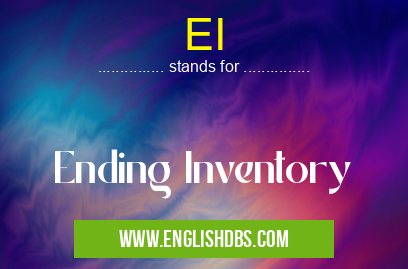What does EI mean in ACCOUNTING
Ending inventory (EI) is a term used in business accounting to refer to the value of all inventory that has not been sold during an accounting period. The figure is calculated at the end of each accounting period and helps businesses determine their cost of goods sold and their gross profit for the period. This information can be used to track performance, understand costs, and develop new strategies for growth. Knowing the ending inventory value is an important part of running a successful business.

EI meaning in Accounting in Business
EI mostly used in an acronym Accounting in Category Business that means Ending Inventory
Shorthand: EI,
Full Form: Ending Inventory
For more information of "Ending Inventory", see the section below.
» Business » Accounting
Definition
Ending inventory (EI) is the number of items in stock at the end of an accounting period. It includes any leftover products from the beginning of the period as well as any newly purchased items. Ending inventory is subtracted from total sales to calculate cost of goods sold (COGS) and then added back to net income (or subtracts from it) depending on whether there was a net increase or decrease in COGS during that period.
Calculating Ending Inventory
Ending inventory is calculated by taking the beginning inventory figure from the start of the accounting period and adding any purchases made throughout the period. Any sales made during this time are then subtracted to get total ending inventory for that specific time frame. Increases in ending inventory signify a net increase in COGS while decreases signify a net decrease in COGS - this will affect overall profitability, so tracking changes over time can help business owners optimize operations accordingly.
Why it's Important
The ending inventory figure provides insight into how much money businesses have tied up in unsold goods (inventory). This information can be used to measure levels of efficiency, understand costs, plan future purchases or production runs more effectively, forecast sales trends, and adjust pricing appropriately among other things. Knowing a company’s EI can also help investors better evaluate that company’s performance and make sound decisions about investing options moving forward.
Essential Questions and Answers on Ending Inventory in "BUSINESS»ACCOUNTING"
What is Ending Inventory?
Ending Inventory (EI) refers to the value of inventory that a business has on hand at the end of an accounting period. This figure is produced in order to calculate the Cost of Goods Sold (COGS). Thus, EI is an important element for understanding a company's profitability and performance.
What components are included in Ending Inventory?
Ending Inventory includes all physical items and associated costs, such as raw materials, finished goods used for resale, supplies, and direct labor costs.
How do businesses calculate their Ending Inventory?
Generally speaking, businesses use three methods to determine Ending Inventory: The First In First Out (FIFO), Last In First Out (LIFO), and Weighted Average Cost methods. By comparing these calculations with actual counts, companies can ensure accuracy in their reporting.
How often should companies put effort into calculating their Ending Inventory?
Businesses should determine their Ending Inventory at least once every month or quarter. It is also critical to make sure all physical products have been counted and logged accurately. Doing so ensures financial records remain accurate and up-to-date.
What are some best practices when it comes to managing inventory?
Properly managing inventory allows businesses to identify problems quickly and take preventive measures accordingly. For best results, businesses should maintain accurate records of purchases, sales, returns/refunds as well as setup safety stock levels that minimize the risk of running out of goods while still keeping expenses low.
Is there any way to streamline the process of calculating EI?
Yes! Many modern accounting software solutions feature inventory management capabilities that automate much of the manual work involved in calculating EI. Not only does this offer access real-time insights but also reduces errors caused by human error.
Why is it important to account for Ending Inventory accurately?
Accurate calculations help avoid costly mistakes that can affect profitability when reporting COGS or potentially lead to tax liabilities due to underreporting profits or overstating deductions. Inaccuracies may even lead regulators or auditors interested in a company's affairs by flagging suspicious activity.
Can manual processes produce accurate estimates for EI?
Although manual processes are possible they are time consuming and prone to inaccuracies not only because they lack automation but also due to challenges with properly counting physical inventory items each month or quarter.
Final Words:
Ending inventory (EI) is an important metric for businesses looking to optimize operations and maximize profits on sales over time. By using EI calculations together with other metrics such as cost of goods sold (COGS), companies can make accurate projections about profitability and build stronger growth strategies going forward. Ultimately, understanding your ending inventories gives you insights into what works best for your product line so you can make smarter business decisions going forward.
EI also stands for: |
|
| All stands for EI |
